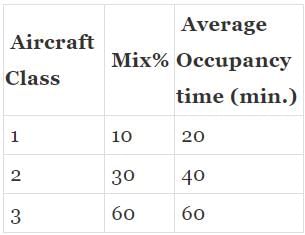Test: Airport Engineering - 3 - Civil Engineering (CE) MCQ
20 Questions MCQ Test - Test: Airport Engineering - 3
According to ICAO recommendations, what is the rate of elevation correction "for the runway length above MSL?
| 1 Crore+ students have signed up on EduRev. Have you? Download the App |
What does the Wind Rose Diagram (WRD) for orientation of airport runway give?
Which one of the following statements is correct? Compared to IFR conditions, the runaway capacity of a runway operating under VFR conditions:
As per ICAO recommendation, minimum width of safety area for instrumental runway should be
As per ICAO for A, B and C type of airports, maximum effective, transverse and longitudinal grades in percentage respectively are
The capacity of a gate which is available to all classes of aircraft as per details given in table will be

The capacity of parallel runway pattern depends upon
If the monthly mean of average daily temperature for the hottest month of the year is 25°C and the monthly mean.of the maximum daily temperature of the same month of the year is 46ºC, the airport reference temperature is
Consider the following statements regarding ICAO recommendation for correction to basic runway length
1. The basic runway length should be increased at the rate of 7 percent per 300 m rise in elevation above the mean sea level.
2. The basic runway length after having been corrected for elevation should be further increased at the rate of 1 percent for every 1°C rise in airport reference temperature above the standard atmospheric temperature at that elevation.
3. The runway length after having been corrected for elevation and temperature should be further 1 percent of effective gradient.
Which of these statements is/are correct? .
The total length of a runway is 1000 m. The elevation at distance, 0, 200 m, 400 m, 600 m, 800 m and 1000 m are 100.0 m, 101.0 m respectively. The effective gradient of runway will be
The length of runway under standard conditions is 2000 m. The elevation of airport site is 300 m. Its reference temperature is 33.05°C. if the runway is to be constructed with an effective gradient of 0.25 percent, the correct runway length will be
As per ICAO, the minimum basic runway length for A and E type of airport will be
The cruising speed for the aircraft is 500 kmph. If there is a head wind of 50 kmph, then the air speed and ground speed of the aircraft respectively will be
Calm period is the percentage of time during which wind intensity is less than
For determining the basic runway length, the landing case requires that aircraft should come to a stop within p% of the landing distance. The value of p is
The width and interval of transverse centre line bars along the extended centre line of runway, in approach lighting system are
In Instrumental landing system, the middle markers are located
























